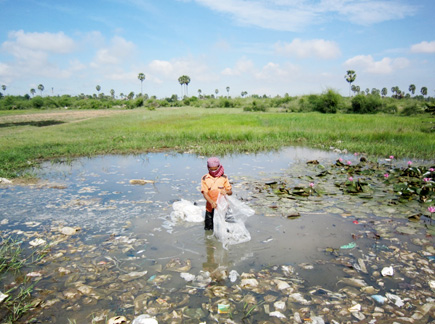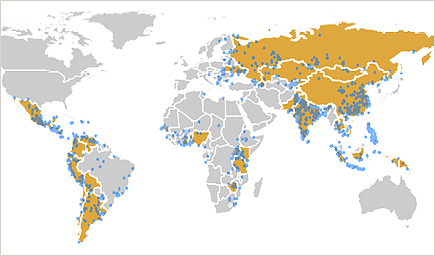
The World's Worst Pollution Problems 2012:
The Top Ten Sources by Global Burden of Disease
This report illustrates the tremendous burden put on the health of the world’s population by the release of toxic pollution from industrial and mining processes. As noted, these estimates of global disease burdens from toxic pollution are likely undervalued as many of the suspected and known health impacts of pollution are currently unquantifiable. In addition, pathway types, sampling capabilities, demographic data and access to polluted sites limited these estimates. However, this first attempt to assign DALYs to top polluting industrial sources clearly demonstrates the scope of the problem.
In total, the 2600 sites investigated by the Blacksmith Institute and Green Cross Switzerland put close to 80 million people at risk for a wide range of health impacts. From this research Blacksmith Institute estimates that close to 125 million people are at risk from industrial pollution worldwide. The total global DALYs attributable to pollution from industrial sources are estimated to be 17 million. This is large enough to be compared to disease burdens from other well-documented widespread diseases such as tuberculosis and malaria. The international community aggressively targets these diseases and continually allocates resources to eradicating them in developing countries. These well placed resources have made great strides in lowering the DALYs associated with these diseases. Unfortunately, despite the fact that the global burden of disease from toxic pollution is as serious, very limited resources are allocated to the prevention and remediation of polluted sites. Developing countries need the support of the international community to design and implement clean up efforts, improve pollution control technologies, and provide educational trainings to industry workers and the surrounding community.
Blacksmith, along with Green Cross Switzerland continues to identify and assess sites contaminated by toxic pollution in order to reduce the significant human health risks it causes. Continuing research and analysis of these sites will prove to further establish the expanding scope of this slow-moving public health disaster.
Blacksmith, along with Green Cross Switzerland continues to identify and assess sites contaminated by toxic pollution in order to reduce the significant human health risks it causes. Continuing research and analysis of these sites will prove to further establish the expanding scope of this slow-moving public health disaster.

The scale of these issues is too large to be addressed solely by NGOs. Country governments are making important progress in dealing with the problem. However, further efforts are required and international support for country governments is essential.
While the problem of toxic pollution is invasive and prevalent, the solutions to treat and prevent it already exist and are ready to be implemented. The project examples presented in this report prove that the solutions to toxic problems are typically cost-effective and technically feasible. By engaging local entities and working together with public and private partners Blacksmith has proven that solutions can be delivered efficiently and effectively. The power to prevent hundreds of thousands of deaths and improve the quality of life of millions is in our hands; all that is missing is the determination and resources to implement the solutions.
While the problem of toxic pollution is invasive and prevalent, the solutions to treat and prevent it already exist and are ready to be implemented. The project examples presented in this report prove that the solutions to toxic problems are typically cost-effective and technically feasible. By engaging local entities and working together with public and private partners Blacksmith has proven that solutions can be delivered efficiently and effectively. The power to prevent hundreds of thousands of deaths and improve the quality of life of millions is in our hands; all that is missing is the determination and resources to implement the solutions.
The World’s Worst Pollution Problems Report is based on information collected as part of the Toxic Sites Identification Program (TSIP). The TSIP is implemented jointly by Blacksmith Institute and the United Nations Industrial Development Organization (UNIDO). The TSIP is supported in part with funding from the European Commission, the Asian Development Bank and the World Bank.
Note: Earlier versions of this report contained potential inaccurate or unclear categorizations of certain activities related to lead processing. The report has been amended to correct these potentially errors.
Note: Earlier versions of this report contained potential inaccurate or unclear categorizations of certain activities related to lead processing. The report has been amended to correct these potentially errors.






0 comments:
Post a Comment